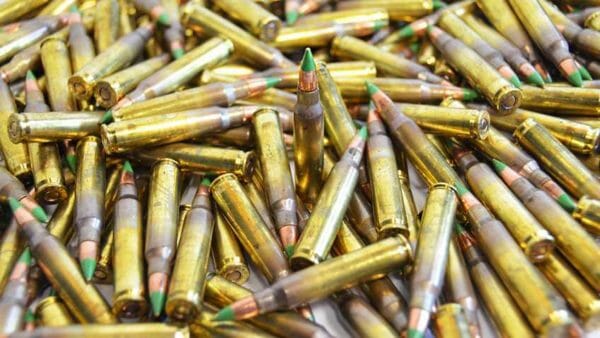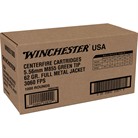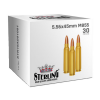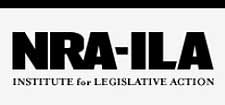Opinion

Here we go again. Every so often, some “brilliant” firearm prohibitionist comes up with the “insight” that if gun bans are unconstitutional, ammunition should be targeted instead.
This is akin to the old tactic of cracking down on ink and paper supplies as a means of curtailing First Amendment expression and is just as unconstitutional. We saw an attempt by the government to ban one of the most popular types of ammunition for America’s most popular rifle during the Obama/Biden administration, when ATF suddenly (and inaccurately) reclassified M855 rounds as “armor piercing.” That overreaching move not only failed to go the distance, it was followed by the resignation of the ATF’s then director, B. Todd Jones. Now, as Gun Control, Inc. continues to recycle the failed executive gun control schemes of the past, another attempt is underway to ban supposed “military grade” ammunition from public sale.
It goes without saying that there are certain types of technology that have both military and civilian applications. Thus, some companies serve both the military and civilian markets with the same or similar items. This includes Lake City Army Ammunition Plant in Independence Missouri, currently operated by Olin Winchester, a private company. Lake City makes rifle cartridges for both the military and civilian markets, including in the highly popular 5.56×45 mm designation used in military firearms such as the M4 and in civilian firearms such as the AR-15.
This arrangement allows for economies of scale that benefit taxpayers, U.S. fighting forces, and Americans exercising their Second Amendment Rights. By serving both military and civilian markets, Lake City can maintain the machinery, infrastructure, staffing, and supply chain purchasing power to produce consistent, high-quality ammunition at affordable prices. It also allows the plant to “surge” its capacity when necessary to meet military needs during times of high demand, such as when U.S. forces are engaged in combat operations.
Moreover, while Lake City can sell certain types of its output on the civilian market, these sales are still subject to the same laws and regulations that govern ammunition sales from any other source. Lake City cannot, for example, sell armor-piercing ammunition in the private market because such sales are restricted under specific provisions of federal law. Certain types of ammunition might also be considered an explosive or destructive device under federal law, and restrictions and requirements that pertain to those categories would of course govern those rounds, no matter where or by whom they were produced.
It’s also worth noting that the U.S. government itself makes certain types of surplus military equipment available to the private markets in the U.S., either directly or through intermediaries. These include actual firearms once belonging to military armories – including semiautomatic firearms like the M1 Garand rifle, the M1 carbine, and the M1911 pistol – and once-fired military cartridge cases (including those produced by Lake City), which can be reloaded into usable rounds. Military equipment is ultimately funded by U.S. taxpayers, and if it is otherwise legal for civilian use and no longer needed by the services for the common defense, it makes sense it be made available to the public, rather than destroyed or stored at taxpayer expense.
Indeed, all this has gone on for many decades openly and without many complaints, even by anti-gunners.
The latest flap over Lake City selling ammunition to the public is the perfect example of how firearm prohibitionists across the public and private spheres coordinate in pushing a contrived narrative to generate fear and outrage and, so they hope, use it to crack down on Second Amendment rights. These interconnected activists, all pressing for the same agenda, pretend to act independently but are really part of a coordinated effort.
First, there were rumblings back in June 2022 that the government’s leading ammunition contractor might shut off the supply of its products to the civilian market. That plan, perhaps because of looming midterm elections, did not come to fruition at the time.
Then, a supposed “investigation” by the New York Times last November reported that Lake City has “pumped billions of rounds of military-grade ammunition into the commercial market.” That article claimed some of these rounds had been used in certain notorious and highly-publicized crimes. It even quoted the writings of one mass shooter who supposedly sought out Lake City ammunition to use in his attack. The article’s takeaway is that the U.S. government, and by extension the U.S. taxpayer, are “subsidizing” “military-grade” ammunition for sale to the general public that is being diverted to criminal use.
Of course, even taking the Times article at face value, it could also be read to say that billions of Lake City rounds are being bought and used by the general public in completely legitimate and constitutionally-protected ways. The Times does not claim, nor can it, that the rounds that Lake City makes available to the public are inherently more deadly or liable to be misused in crime than any other brand of ammunition of the same caliber. Again, taking the Times at its word, the rounds have been linked to 12 recent mass shootings. But if the Times is to be believed (and it shouldn’t be), hundreds of such crimes occur a year without any connection to Lake City ammunition whatsoever.
The Times apparent object in singling out Lake City is simply that the rounds are prolific, which means they influence the availability and price of 5.56×45 mm ammunition generally. And they have a tie to the government, which means highlighting and exaggerating misuse might give the anti-gun Biden White House an excuse for a crackdown.
But the Times reporting should not be taken at face value. First is the issue of how the Times is supposedly substantiating which brand of ammunition is used in which particular crimes. Firearms in the U.S., for example, bear mandatory identification marks and serial numbers that reliably allow them to be traced back to a particular manufacturer or importer, and even to a particular initial retail purchaser. Thus, when a claim is made about a certain type or brand of firearm being used in a certain crime, there is usually an ATF trace of a recovered gun that can back up (or disprove) that claim.
Live Inventory Price Checker
 |
Winchester Usa White Box M855 Green Tip 5.56mm Rifle Ammo | Brownells.com | $ 679.99 | |
 |
DOUBLETAP AMMUNITION M855 | Guns.com | $ 17.99 | |
 |
PMC Ammunition X-Tac Rifle Ammunition 5.56 NATO 62 gr Green Tip 1000/ct 5.56 M855 Case | Optics Planet | $ 708.99 | |
 |
Sterling 5.56x45mm M855 Ammunition 30 Rounds - 500.5.56.M855 | Palmetto State Armory | $ 19.99 | |
 |
Winchester USA 5.56x45mm 62gr M855 Green Tip 1000-Round Case | GunMag Warehouse | $ 649.99 |
Ammunition, by contrast, is not required to be serialized, nor can the manufacturing and distribution data for individual rounds be determined with the same precision.
The Times report appears to rely mostly on the recovery of rounds or spent brass with what reporters or law enforcement officials believe to be Lake City headstamps on the back of cartridge cases. But assuming these non-experts in ammunition identification are right even about that, the headstamp says nothing about how the rounds or brass were actually manufactured or distributed. For example, maybe the rounds were reloaded into Lake City brass by a private company or person, perhaps even from brass discarded at a public shooting range. Maybe the round or the brass came directly from military stockpiles, including by unauthorized diversion. Simply put, there is no universally accepted or used method of tracking which brands of ammunition are used in crime. Meanwhile, agenda-driven reporters pushing a narrative are free to use whatever supposed evidence or hearsay they want to make these claims.
The Times “investigation,” however, had its intended effect, generating other “news” stories amplifying and expanding upon the narrative, as well as outrage from gun control advocates and anti-gun politicians (some of whom have had access to this information for years).
Lake City Army Ammunition Plant is a federal site that has supplied the military with ammo since World War II, but as military demand has slowed, billions of rounds have been sold commercially. Many of these rounds have been traced to crime, including 12 mass shootings. https://t.co/3Bye7t3ukl
— Brady | United Against Gun Violence (@bradybuzz) November 21, 2023
The most recent effort was spearheaded by none other than New York Attorney General Letitia James, who specializes in shamelessly wielding her official authority against political opponents of her own Democrat party. James is the nominal author of a letter written on Jan. 9, 2024, and signed by 19 other anti-gun Democrat state attorneys general, demanding that the White House Office of Gun Violence Prevention:
“investigate the contracting and manufacturing practices that led to so many billions of military-grade rounds being sold into our communities, and to issue a public report with recommendations about how to end the diversion of military ammunition into civilian hands.” But the letter goes further, betraying the true agenda and purpose of the entire effort: “In the long term, we ask the White House to ensure that future production contracts prohibit the sale of military weapons and ammunition to civilians.”
It’s typical that the letter confuses the issue by conflating “weapons and ammunition,” even though no weapons (other than ammunition) produced under military contracts were implicated in the Times’s reporting. It also uses the scary-sounding buzzword “military-grade” to falsely suggest there is some important functional difference between Lake City rounds and other 5.56.45 mm rounds available on the civilian market. In fact, “military-grade” in this context simply means it meets specific technical specifications for materials, tolerances, consistency, quality control, and oversight, not that it is uniquely suited to military use, nor more deadly than other brands of the same round. As previously stated, Lake City can only offer rounds for sale to the public that are otherwise legal for commercial distribution. If anything, international accords that limit the use of certain ammunition designs in warfare arguably make true “military-grade” ammunition of a given caliber less likely to cause especially grievous wounds or suffering.
Restricting the sale of Lake City ammunition to the general public would severely curtail the availability of rounds for America’s most popular rifle, the AR-15, and drive up prices.
Reports indicate that Lake City Ammunition accounts for 30% of the commercial supply of 5.56×45 mm rounds in the U.S. Banning access to those rounds would not stop determined criminals who were willing to die or go to jail to perpetuate a heinous, high-profile crime. But it would make it much more difficult for law-abiding Americans to exercise their Second Amendment rights and to maintain competency with their legally-owned guns.
Of course, that last outcome is the entire point of the whole effort.
Read Related: Attorney Generals Ask Biden to Ban Lake City from Selling Ammo to Civilians
About NRA-ILA:
Established in 1975, the Institute for Legislative Action (ILA) is the “lobbying” arm of the National Rifle Association of America. ILA is responsible for preserving the right of all law-abiding individuals in the legislative, political, and legal arenas, to purchase, possess, and use firearms for legitimate purposes as guaranteed by the Second Amendment to the U.S. Constitution. Visit: www.nra.org

from https://ift.tt/iqMFXGf
via IFTTT

No comments:
Post a Comment